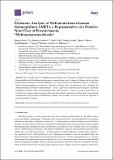Por favor, use este identificador para citar o enlazar a este item:
http://hdl.handle.net/10261/161432COMPARTIR / EXPORTAR:
 SHARE SHARE
 CORE
BASE CORE
BASE
|
|
| Visualizar otros formatos: MARC | Dublin Core | RDF | ORE | MODS | METS | DIDL | DATACITE | |

| Campo DC | Valor | Lengua/Idioma |
|---|---|---|
| dc.contributor.author | Ferrer, Manuel | - |
| dc.contributor.author | Sorokin, Dimitry Y. | - |
| dc.contributor.author | Wolf, Yuri I. | - |
| dc.contributor.author | Ciordia, Sergio | - |
| dc.contributor.author | Mena, M. Carmen | - |
| dc.contributor.author | Bargiela, Rafael | - |
| dc.contributor.author | Koonin, Eugene V. | - |
| dc.contributor.author | Makarova, Kira S. | - |
| dc.date.accessioned | 2018-02-27T14:26:01Z | - |
| dc.date.available | 2018-02-27T14:26:01Z | - |
| dc.date.issued | 2018-01-23 | - |
| dc.identifier | doi: 10.3390/genes9020028 | - |
| dc.identifier.citation | Genes 9 (2): 28 (2018) | - |
| dc.identifier.uri | http://hdl.handle.net/10261/161432 | - |
| dc.description.abstract | The recently discovered Methanonatronarchaeia are extremely halophilic and moderately thermophilic methyl-reducing methanogens representing a novel class-level lineage in the phylum Euryarchaeota related to the class Halobacteria. Here we present a detailed analysis of 1D-nano liquid chromatography–electrospray ionization tandem mass spectrometry data obtained for “Methanonatronarchaeum thermophilum” AMET1 grown in different physiological conditions, including variation of the growth temperature and substrates. Analysis of these data allows us to refine the current understanding of the key biosynthetic pathways of this triple extremophilic methanogenic euryarchaeon and identify proteins that are likely to be involved in its response to growth condition changes. | - |
| dc.description.sponsorship | D.Y.S. was supported by Gravitation-SIAM Program (grant 24002002, Dutch Ministry of Education and Science) and by RFBR (grant 16-04-00035). K.S.M., Y.I.W. and E.V.K. are supported by the intramural program of the U.S. Department of Health and Human Services (to the National Library of Medicine). The proteomic analysis was performed in the Proteomics Facility of The Spanish National Centre for Biotechnology (CNB-CSIC) that belongs to ProteoRed, PRB2-ISCIII, supported by grant PT13/0001. This project has received funding from the European Union’s Horizon 2020 research and innovation program [Blue Growth: Unlocking the potential of Seas and Oceans] under grant agreement No [634486]. This work was further funded by grants BIO2014-54494-R, BIO2017-85522-R, PCIN-2014-107 (within the ERA NET-IB2 program), PCIN-2017-078 (within the ERA-MarineBiotech program) from the Spanish Ministry of Economy, Industry and Competitiveness and grant AC17/00022 from the Instituto de Salud Carlos III (within the ERA TRANSCAN-2 program). | - |
| dc.publisher | Multidisciplinary Digital Publishing Institute | - |
| dc.relation | info:eu-repo/grantAgreement/MINECO/Plan Estatal de Investigación Científica y Técnica y de Innovación 2013-2016/BIO2014-54494-R | - |
| dc.relation | info:eu-repo/grantAgreement/EC/H2020/634486 | - |
| dc.relation | info:eu-repo/grantAgreement/MINECO/Plan Estatal de Investigación Científica y Técnica y de Innovación 2013-2016/BIO2017-85522-R | - |
| dc.relation | info:eu-repo/grantAgreement/MINECO/Plan Estatal de Investigación Científica y Técnica y de Innovación 2013-2016/PCIN-2014-107 | - |
| dc.relation | info:eu-repo/grantAgreement/MINECO/Plan Estatal de Investigación Científica y Técnica y de Innovación 2013-2016/PCIN-2017-078 | - |
| dc.rights | openAccess | - |
| dc.title | Proteomic Analysis of Methanonatronarchaeum thermophilum AMET1, a Representative of a Putative New Class of Euryarchaeota, “Methanonatronarchaeia” | - |
| dc.type | artículo | - |
| dc.identifier.doi | 10.3390/genes9020028 | - |
| dc.relation.publisherversion | http://dx.doi.org/10.3390/genes9020028 | - |
| dc.identifier.e-issn | 2073-4425 | - |
| dc.date.updated | 2018-02-27T14:26:01Z | - |
| dc.rights.license | http://creativecommons.org/licenses/by/4.0/ | - |
| dc.contributor.funder | Ministry of Education, Culture and Science (The Netherlands) | - |
| dc.contributor.funder | Department of Health and Human Services (US) | - |
| dc.contributor.funder | CSIC - Centro Nacional de Biotecnología (CNB) | - |
| dc.contributor.funder | Ministerio de Economía, Industria y Competitividad (España) | - |
| dc.contributor.funder | European Commission | - |
| dc.contributor.funder | Instituto de Salud Carlos III | - |
| dc.identifier.funder | http://dx.doi.org/10.13039/501100004587 | es_ES |
| dc.identifier.funder | http://dx.doi.org/10.13039/501100000780 | es_ES |
| dc.identifier.funder | http://dx.doi.org/10.13039/100000016 | es_ES |
| dc.identifier.funder | http://dx.doi.org/10.13039/501100010198 | es_ES |
| dc.identifier.pmid | 29360740 | - |
| dc.type.coar | http://purl.org/coar/resource_type/c_6501 | es_ES |
| item.fulltext | With Fulltext | - |
| item.openairecristype | http://purl.org/coar/resource_type/c_18cf | - |
| item.openairetype | artículo | - |
| item.cerifentitytype | Publications | - |
| item.grantfulltext | open | - |
| Aparece en las colecciones: | (ICP) Artículos (CNB) Artículos | |
Ficheros en este ítem:
| Fichero | Descripción | Tamaño | Formato | |
|---|---|---|---|---|
| genes-09-00028.pdf | 1,58 MB | Adobe PDF |  Visualizar/Abrir |
CORE Recommender
PubMed Central
Citations
3
checked on 23-abr-2024
SCOPUSTM
Citations
4
checked on 23-abr-2024
WEB OF SCIENCETM
Citations
4
checked on 28-feb-2024
Page view(s)
324
checked on 24-abr-2024
Download(s)
256
checked on 24-abr-2024

